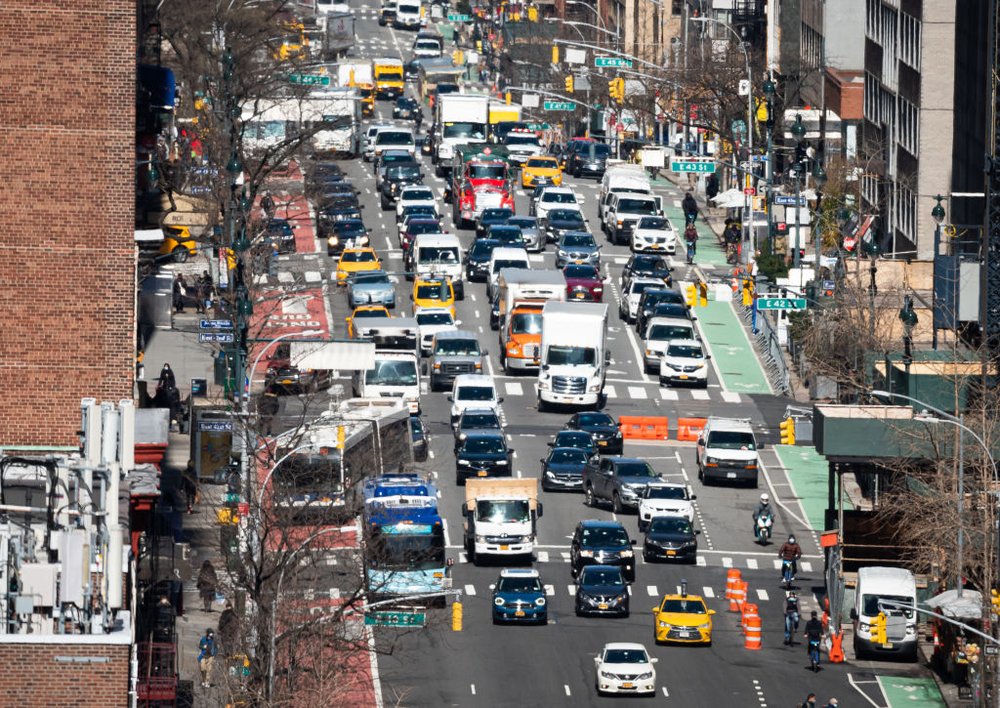Manhattan’s 2nd Avenue would get 24/7 bus lane, wider bike lane under proposed redesign
March 4, 2024, 7:02 p.m.
Officials are advancing a redesign for the avenue between 59th and Houston streets.

A nearly three-mile stretch of Second Avenue in Manhattan would get a 24/7 bus lane, a wider bike lane and other safety-oriented changes under a proposed redesign, transportation officials said Monday.
In a statement, city Department of Transportation Commissioner Ydanis Rodriguez said the redesign “would make commutes faster and more reliable for 57,000 daily bus riders, better protect the increasing number of cyclists, and improve safety for all road users.”
The DOT is still finalizing the project, but a recent draft of the plan currently includes increasing the width of parts of Second Avenue’s protected bike lane to up to 10 feet — from 6 feet — and shifting the dedicated bus lane one lane over from the curbside while extending its dedicated hours beyond just rush hour to all day.
Second Avenue is one of the city’s busiest bus and bike corridors, according to transportation officials. Residents have also complained that it’s home to some of the worst traffic congestion in the city as cars compete with buses between the 59th Street Bridge and the Midtown Tunnel.
“I think you'll find most members of the committee are really concerned about congestion and too much traffic so both of these things sound like they'd be very helpful,” Sandra McKee, chair of Manhattan’s Community Board 6, said in a phone interview on Monday.
The DOT didn’t have cost estimates and plans to use its current budget allocation. Officials plan to present details of the redesign to the community board Monday night. The board will likely provide its feedback in April, with the goal of implementing the project starting this year.
Jonathan Orcutt, a former DOT official, said the new offset bus lane will move it off the curb and help the buses travel faster.
“The curb is the most competitive space in the city,” Orcutt said in a phone interview Monday. “It's often violated by deliveries or people stopping.”
The new offset bus lane resolves the delicate problem of the NYPD’s 13th Precinct vehicles blocking the bus lane by allowing police to continue parking outside the precinct. Residents had previously attempted to broker a deal with the NYPD by giving them dedicated parking on the street, but the plan was never implemented.
The MTA applauded the plan’s offset bus lane and said the Second Avenue’s M15 bus saw 57,000 riders a day.
“Along with traffic reduction from congestion pricing, shifting the bus lane away from the curb and making it active 24/7 will shorten wait times and bring faster service, our customers’ top requests for increased bus satisfaction,” New York City Transit President Richard Davey wrote in an email.
The design also attempts to solve another community concern of illegal parking in the pedestrian islands. Instead of a painted island, which cars simply park on, the DOT said it plans to build concrete islands.
Orcutt called the wider bike lanes “rare good news.” He said the DOT had been talking about them for about 18 months, ever since the boom of micromobility devices such as e-bikes and e-scooters.
“I appreciate the idea of coming back and improving the infrastructure that we already have,” Orcutt said. “Especially if the lanes are going to get parked up or violated all the time.”